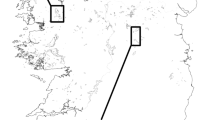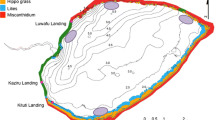Abstract
Climate change is anticipated to have differential effects on the salmonid and percid-cyprinid components of lake fish communities, which may in turn impact the foraging conditions and so population biology of top aquatic predators including northern pike (Esox lucius Linnaeus). Since the 1940s, extensive monitoring has been undertaken on the northern pike, the salmonid Arctic charr (Salvelinus alpinus) and the percid Eurasian perch (Perca fluviatilis) populations and environmental features of the mesotrophic north and eutrophic south basins of Windermere in the English Lake District, UK Analysis of data from 1982 to 2006 revealed basin-specific changes in the degree of eutrophication, but a common warming of the lake in the 1990s was accompanied by contrasting trends in the two basins’ northern pike populations. Following a common temporary increase in catch-per-unit-effort (CPUE) during the 1980s in response to a lake-wide decrease in fishing pressure, CPUE of the south basin subsequently decreased while that of the north basin showed a second increase in the late 1990s to reach a peak in 2000. In addition, the mean weight at length of female northern pike was initially similar between the two basins but then increased in the north basin from the early 1990s to the early 2000s before decreasing, while in the south basin it has shown a decrease since 2000. These changes are interpreted with respect to contrasting trends in potential prey populations, including an overall decrease in the abundance of the coldwater Arctic charr, particularly in the more eutrophic south basin where hypolimnetic oxygen levels have fallen to very low levels, and a recent marked increase in the abundance of the warmwater roach (Rutilus rutilus) in both basins. It is concluded that although indirect in nature, the recent warming of Windermere has had a significant impact on its northern pike populations.




Similar content being viewed by others
References
Ahas, R., 1999. Long-term phyto-, ornitho- and ichthyophenological time-series analyses in Estonia. International Journal of Biometeorology 42: 119–123.
Appelberg, M., 2000. Swedish standard methods for sampling freshwater fish with multi-mesh gillnets. Fiskeriverket Information 1: 3–32.
Beamish, R. J., 1995. The need to understand the relationship between climate and the dynamics of fish populations. In Beamish, R. J. (ed.), Climate Change and Northern Fish Populations. Canadian Special Publication of Fisheries and Aquatic Sciences 121: 1–2.
Carlson, S. M., E. Édeline, L. Vøllestad, T. O. Haugen, I. J. Winfield, J. M. Fletcher, J. B. James & N. Chr. Stenseth, 2007. Four decades of opposing natural and human-induced artificial selection acting on Windermere pike (Esox lucius). Ecology Letters 10: 512–521.
Casselman, J. M., 1996. Age, growth and environmental requirements of pike. In Craig, J. F. (ed.), Pike: Biology and Exploitation. Chapman & Hall Fish and Fisheries Series 19. Chapman & Hall, London: 69–101.
Casselman, J. M., 2002. Effects of temperature, global extremes, and climate change on year-class production of warmwater, coolwater, and coldwater fishes in the great lakes basin. American Fisheries Society Symposium 32: 39–60.
Chapman, C. A. & W. C. Mackay, 1984. Versatility in habitat use by a top aquatic predator, Esox lucius L. Journal of Fish Biology 25: 109–115.
Craig, J. F., 1996. Pike: Biology and Exploitation. Chapman & Hall Fish and Fisheries Series 19. Chapman & Hall, London.
Craig, J. F. & J. M. Fletcher, 1981. Some results of fishing with survey gill nets in Windermere. Proceedings of the Second British Freshwater Fisheries Conference. University of Liverpool, Liverpool: 236–244.
Craig, J. F. & J. A. Babaluk, 1989. Relationship of Condition of Walleye (Stizostedion vitreum) and Northern Pike (Esox lucius) to Water Clarity, with Special Reference to Dauphin Lake, Manitoba. Canadian Journal of Fisheries and Aquatic Sciences 46: 1581–1586.
Elliott, J. M., J. M. Fletcher, J. A. Elliott, P. R. Cubby & E. Baroudy, 1996. Changes in the population density of pelagic salmonids in relation to changes in lake enrichment in Windermere (northwest England). Ecology of Freshwater Fish 5: 153–162.
Fretwell, S. D. & H. J. Lucas, 1970. On territorial behavior and other factors influencing habitat distributions in birds. Acta Biotheoretica 19: 16–36.
Frost, W. E., 1954. The food of Pike, Esox lucius L., in Windermere. Journal of Animal Ecology 23: 339–360.
Frost, W. E., 1977. The food of charr, Salvelinus willoughbii Gunther, in Windermere. Journal of Fish Biology 11: 531–547.
Frost, W. E. & C. Kipling, 1959. The determination of the age and growth of pike (Esox lucius L.) in Windermere. Journal du Conseil International pour l’exploration de la Mer 24: 314–341.
Haugen, T. O., I. J. Winfield, L. A. Vøllestad, J. M. Fletcher, J. B. James & N. Chr. Stenseth, 2006. The ideal free pike: 50 years of fitness-maximizing dispersal in Windermere. Proceedings of the Royal Society, Series B 273: 2917–2924.
Heaney, S. I., J. W. G. Lund, H. M. Canter & K. Gray, 1988. Population dynamics of Ceratium spp. in three English Lakes. 1945–85. Hydrobiologia 161: 133–148.
Hulme, M., G. J. Jenkins, X. Lu, J. R. Turnpenny, T. D. Mitchell, R. G. Jones, J. Lowe, J. M. Murphy, D. Hassell, P. Boorman, R. McDonald & S. Hill, 2002. Climate Change Scenarios for the United Kingdom: The UKCIP02 Scientific Report. Tyndall Centre for Climate Change Research, School of Environmental Sciences, University of East Anglia, Norwich, UK: 120 pp.
Ishida, Y., T. Hariu, J. Yamashiro, S. McKinnell, T. Matsuda & H. Kaneko, 2001. Archeological evidence of Pacific salmon distribution in northern Japan and implications for future global warming. Progress in Oceanography 49: 539–550.
Janssen, W. & R. H. Hesslein, 2004. Potential effects of climate warming on fish habitats in temperate zone lakes with special reference to Lake 239 of the experimental lakes area (ELA), north-western Ontario. Environmental Biology of Fishes 70: 1–22.
Kipling, C., 1972. The commercial fisheries of Windermere. Transactions of the Cumberland and Westmorland Antiquarian and Archaeological Society 72: 156–204.
Kipling, C., 1984a. A study of perch (Perca fluviatilis L.) and pike (Esox lucius L.) in Windermere from 1941 to 1982. Journal du Conseil permanent international pour l’Exploration de la Mer 41: 259–267.
Kipling, C., 1984b. Some observations on autumn-spawning charr, Salvelinus alpinus L., in Windermere, 1939–1982. Journal of Fish Biology 24: 229–234.
Kipling, C. & E. D. Le Cren, 1984. Mark-recapture experiments on fish in Windermere, 1943–1982. Journal of Fish Biology 24: 395–414.
Le Cren, E. D., 1987. Perch (Perca fluviatilis) and Pike (Esox lucius) in Windermere from 1940 to 1985; Studies in Population Dynamics. Canadian Journal of Fisheries and Aquatic Sciences 44 (Supplement 2): 216–228.
Le Cren, E. D., 2001. The Windermere perch and pike project. Freshwater Forum 15: 3–34.
Lehtonen, H., 1996. Potential effects of global warming on northern European freshwater fish and fisheries. Fisheries Management and Ecology 3: 59–71.
Magnuson, J. J. & B. T. DeStasio, 1997. Thermal niche of fishes and global warming. In Wood, C. M. & D. G. McDonald (eds), Global warming: implications for freshwater and marine fish. Cambridge University Press, Cambridge: 377–408.
McCarthy, I. D. & D. F. Houlihan, 1997. The effect of temperature on protein metabolism in fish: the possible consequences for wild Atlantic salmon (Salmo salar L.) stocks in Europe as a result of global warming. In Wood, C. M. & D. G. McDonald (eds), Global warming: implications for freshwater and marine fish. Cambridge University Press, Cambridge: 51–77.
Mills, C. A., S. I. Heaney, C. Butterwick, J. E. Corry & J. M. Elliott, 1990. Lake enrichment and the status of Windermere charr, Salvelinus alpinus (L.). Journal of Fish Biology (Supplement A) 37: 167–174.
Nunn, A. D., I. G. Cowx, P. A. Frear & J. P. Harvey, 2003. Is water temperature an adequate predictor of recruitment success in cyprinid fish populations in lowland rivers? Freshwater Biology 48: 579–588.
Parker, J. E. & S. C. Maberly, 2000. Biological response to lake remediation by phosphate stripping: control of Cladophora. Freshwater Biology 44: 303–309.
Paxton, C. G. M. & I. J. Winfield, 2000a. Some statistical aspects of the long-term gill net monitoring programme for pike Esox lucius in Windermere (English Lake District). Freshwater Forum 14: 35–50.
Paxton, C. G. M. & I. J. Winfield, 2000b. Population dynamics of underyearling coarse fish. Environment Agency R&D Technical Report W222. Environment Agency, Bristol.
Paxton, C. G. M., I. J. Winfield, J. M. Fletcher, D. G. George & D. P. Hewitt, 2004. Biotic and abiotic influences on the recruitment of perch (Perca fluviatilis) in Windermere, UK. Journal of Fish Biology 65: 1622–1642.
Pickering, A. D., 2001. Windermere: restoring the health of England’s largest lake. Freshwater Biological Association Special Publication No. 11. Freshwater Biological Association, Ambleside.
Plante, C. & J. A. Downing, 1993. Relationship of salmonine production to lake trophic status and temperature. Canadian Journal of Fisheries and Aquatic Sciences 50: 1324–1328.
Power, G., 1990. Salmonid communities in Quebec and Labrador; temperature relations and climate change. Polskie Archiwum Hydrobiologii/Polish Archives of Hydrobiology 38: 13–28.
Watson, J., 1925. The English Lake District Fisheries. T. N. Foulis, Ltd., London & Edinburgh.
Winfield, I. J. & N. C. Durie, 2004. Fish introductions and their management in the English Lake District. Fisheries Management and Ecology 11: 1–7.
Winfield, I. J., J. M. Fletcher, D. P. Hewitt & J. B. James, 2004. Long-term trends in the timing of the spawning season of Eurasian perch (Perca fluviatilis) in the north basin of Windermere, UK. In Barry, T. P. & J. A. Malison (eds), Proceedings of Percis III: The Third International Percid Fish Symposium. University of Wisconsin Sea Grant Institute, Madison: 95–96.
Winfield, I. J., J. M. Fletcher & J. B. James, 2007. The Arctic charr (Salvelinus alpinus) populations of Windermere, UK: population trends associated with eutrophication, climate change and increased abundance of roach (Rutilus rutilus). Environmental Biology of Fishes. DOI 10.1007/s10641-007-9235-4.
Acknowledgements
We would like to thank many colleagues, past and present and too numerous to name individually, for their help in the field and laboratory and for access to their unpublished data. Our colleague Stephen Thackeray provided helpful statistical advice. We are indebted to the late John Cooper and to Bruce Dobson for allowing us to use their records of Arctic charr fishing effort and catches, and to Graeme McKee, Ben Bayliss and colleagues of the Environment Agency for organising the current log book scheme and allowing our use of data from it. We appreciate the work of anonymous reviewers whose comments substantially improved our manuscript. We are also grateful to the Freshwater Biological Association for their joint stewardship of these invaluable long-term data. This work was funded by the Natural Environment Research Council.
Author information
Authors and Affiliations
Corresponding author
Additional information
Guest editors: J. M. Farrell, C. Skov, M. Mingelbier, T. Margenau & J. E. Cooper
International Pike Symposium: Merging Knowledge of Ecology, Biology, and Management for a Circumpolar Species
Rights and permissions
About this article
Cite this article
Winfield, I.J., James, J.B. & Fletcher, J.M. Northern pike (Esox lucius) in a warming lake: changes in population size and individual condition in relation to prey abundance. Hydrobiologia 601, 29–40 (2008). https://doi.org/10.1007/s10750-007-9264-1
Published:
Issue Date:
DOI: https://doi.org/10.1007/s10750-007-9264-1




